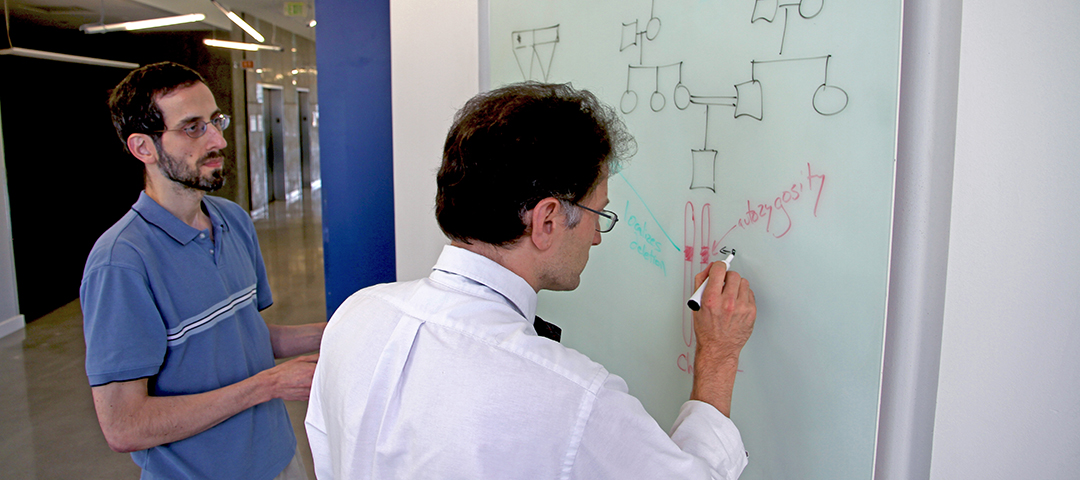Aug. 24, 2014
3 Bullets:
- Adams-Oliver syndrome (AOS) is a rare congenital disease characterized by scalp lesions and limb defects. Additional vascular abnormalities and heart defects can lead to early death in some patients.
- By analyzing twelve families affected with the disease, we identified causal mutations in a new disease gene, NOTCH1, in five families. NOTCH1 is likely to be the major cause of AOS.
- NOTCH1 codes for a transcription factor that governs cell differentiation during embryonic development and throughout life.
Our Family Genomics team at ISB, leveraging collaborations with Millan Patel and Anna Lehman at the University of British Columbia (UBC) and Ben Solomon at the Inova Translational Medicine Institute (ITMI), has recently published two papers on the cause of Adams-Oliver syndrome (AOS). The publication of these papers is largely a result of open communication and sharing between three institutions – with ISB serving as a collaborative hub and analysis center.
AOS is most likely Mendelian: usually a single mutation of sufficient severity in one of several genes leads to the condition. Finding these genes has been painstaking. Mutations in four different genes had previously been reported as causes, typically explaining AOS in one or a few families.
Of the families with AOS analyzed by our team only one had causal mutations in a previously known AOS gene.1 Our analysis of the remaining families revealed a new AOS disease gene, NOTCH1.2 We have found five AOS families, each with a different mutation in NOTCH1: two missense mutations that disrupt disulfide bridges in the NOTCH1 protein, one missense mutation that affects a hydrogen bond in the NOTCH1 protein, one mutation that disrupts a splice site, and in one family the affected child is missing an 85 kilobase chunk of DNA in one copy of the NOTCH1 gene.
We predict that all these mutations affect protein production or function. In three of the families, unaffected parents were available for testing and we found in all of them that the mutations occurred de novo in the affected children. De novo mutations are rare and the fact that we found three that affect the same gene provides evidence that mutations in this gene are causal. We now plan to elucidate the effects of the mutations on the function of the NOTCH1 protein to figure out how they lead to AOS. Interestingly, other mutations in NOTCH1 can cause isolated heart defects and are often found in leukemia cells.
– ISB’s Family Genomics Group
(1)w
Title: Diffuse angiopathy in Adams-Oliver syndrome associated with truncating DOCK6 mutations.
Publication: American Journal of Medical Genetics A
Authors: Anna Lehman, Anna-Barbara Stittrich, Gustavo Glusman, Zheyuan Zong, Hong Li, Patrice Eydoux, Christof Senger, Christopher Lyons, Jared C. Roach and Millan Patel.
Link: onlinelibrary.wiley.com/doi/10.1002/ajmg.a.36685/abstract
(2)
Title: Mutations in NOTCH1 Cause Adams-Oliver Syndrome
Publication: The American Journal of Human Genetics
Authors: Anna-Barbara Stittrich, Anna Lehman, Dale L. Bodian, Justin Ashworth, Zach Zong, Hong Li, Patricia Lam, Alina Khromykh, Ramaswamy K. Iyer, Joseph G.Vockley, Rajiv Baveja, Ermelinda Santos Silva, Joanne Dixon, Eyby L. Leon, Benjamin D. Solomon, Gustavo Glusman, John E. Niederhuber, Jared C. Roach, Millan S. Patel



 isbscience.org/research/analyzing-family-genomics-reveals-new-culprit-in-rare-disease/
isbscience.org/research/analyzing-family-genomics-reveals-new-culprit-in-rare-disease/